Evaluation of Clinical Guidelines on Urinary Tract Infection (UTI)
VerifiedAdded on 2021/11/17
|13
|2690
|74
Report
AI Summary
This report presents a detailed analysis of clinical guidelines for Urinary Tract Infections (UTIs). The report begins with an overview of UTIs, their epidemiology, pathophysiology, and associated morbidity and mortality. It then delves into the development and implementation of clinical practice guidelines, emphasizing the role of the National Institute for Health and Care Excellence (NICE) guidelines. The report provides a comprehensive analysis of the NICE guidelines, including their focus on diagnosis and management, particularly for recurrent infections in women and young children. It evaluates the efficacy of these guidelines and highlights their strengths, such as the emphasis on self-care and reducing antibiotic prescriptions. The analysis also identifies limitations, such as the need for revisions to include guidelines for elderly patients and address lifestyle factors. The report discusses the economic burden of UTIs, including hospitalization costs, and suggests the need for revised guidelines to reduce this burden. Finally, it presents an evaluation of revised guidelines, outlining strategies for assessing their impact on patient health and care. The report concludes by emphasizing the importance of continuous revision and updating of guidelines to improve treatment strategies and enhance patient outcomes.
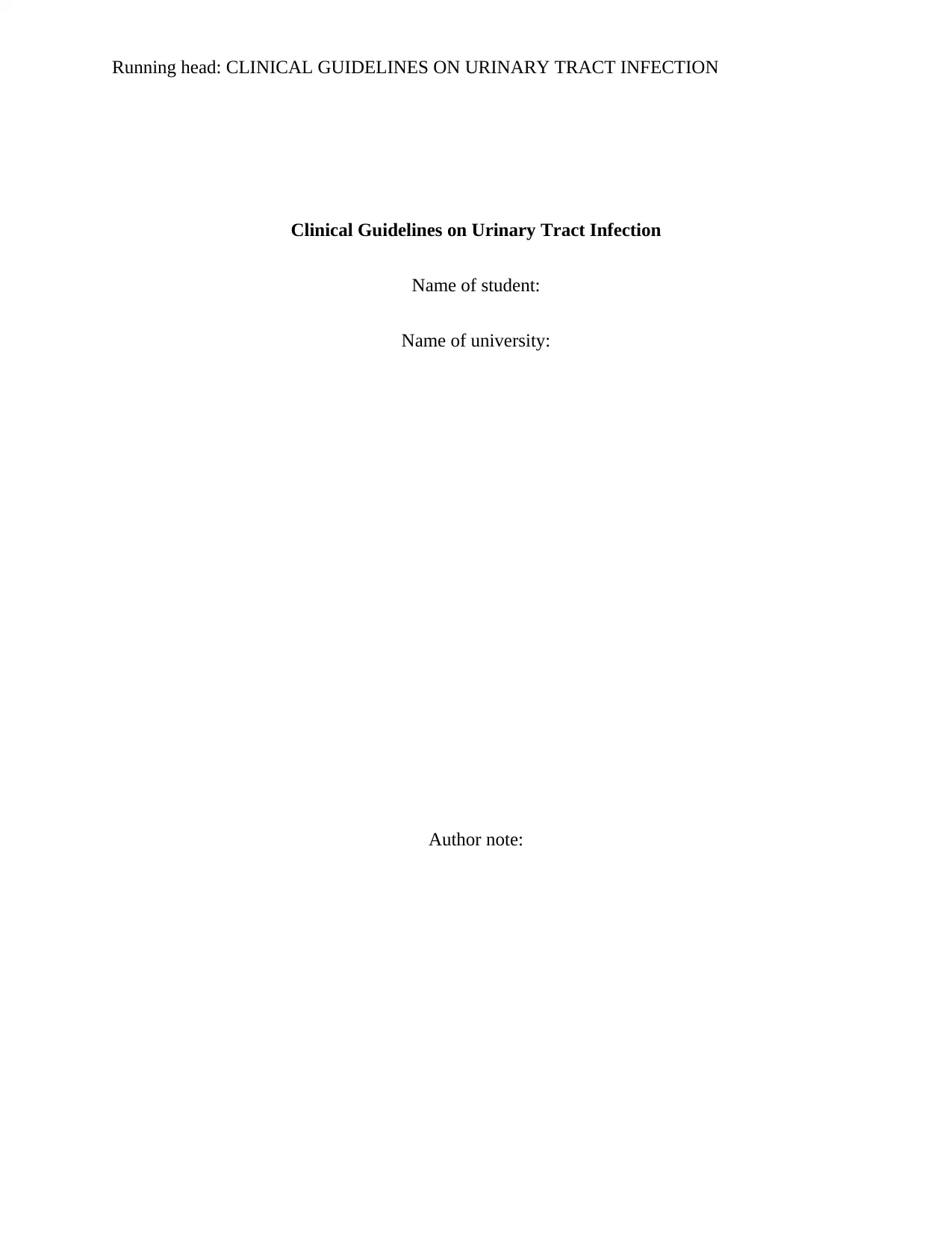
Running head: CLINICAL GUIDELINES ON URINARY TRACT INFECTION
Clinical Guidelines on Urinary Tract Infection
Name of student:
Name of university:
Author note:
Clinical Guidelines on Urinary Tract Infection
Name of student:
Name of university:
Author note:
Paraphrase This Document
Need a fresh take? Get an instant paraphrase of this document with our AI Paraphraser
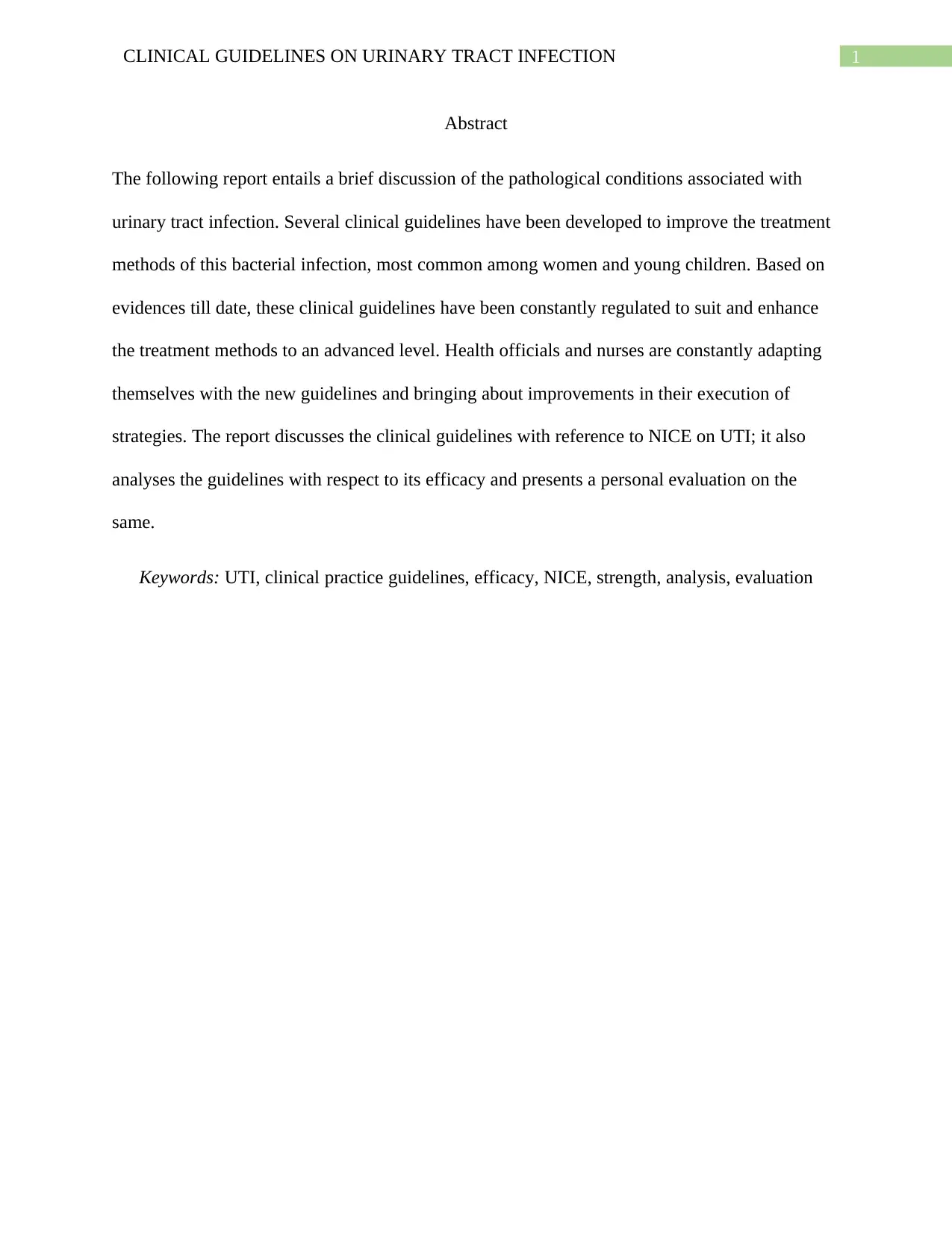
1CLINICAL GUIDELINES ON URINARY TRACT INFECTION
Abstract
The following report entails a brief discussion of the pathological conditions associated with
urinary tract infection. Several clinical guidelines have been developed to improve the treatment
methods of this bacterial infection, most common among women and young children. Based on
evidences till date, these clinical guidelines have been constantly regulated to suit and enhance
the treatment methods to an advanced level. Health officials and nurses are constantly adapting
themselves with the new guidelines and bringing about improvements in their execution of
strategies. The report discusses the clinical guidelines with reference to NICE on UTI; it also
analyses the guidelines with respect to its efficacy and presents a personal evaluation on the
same.
Keywords: UTI, clinical practice guidelines, efficacy, NICE, strength, analysis, evaluation
Abstract
The following report entails a brief discussion of the pathological conditions associated with
urinary tract infection. Several clinical guidelines have been developed to improve the treatment
methods of this bacterial infection, most common among women and young children. Based on
evidences till date, these clinical guidelines have been constantly regulated to suit and enhance
the treatment methods to an advanced level. Health officials and nurses are constantly adapting
themselves with the new guidelines and bringing about improvements in their execution of
strategies. The report discusses the clinical guidelines with reference to NICE on UTI; it also
analyses the guidelines with respect to its efficacy and presents a personal evaluation on the
same.
Keywords: UTI, clinical practice guidelines, efficacy, NICE, strength, analysis, evaluation
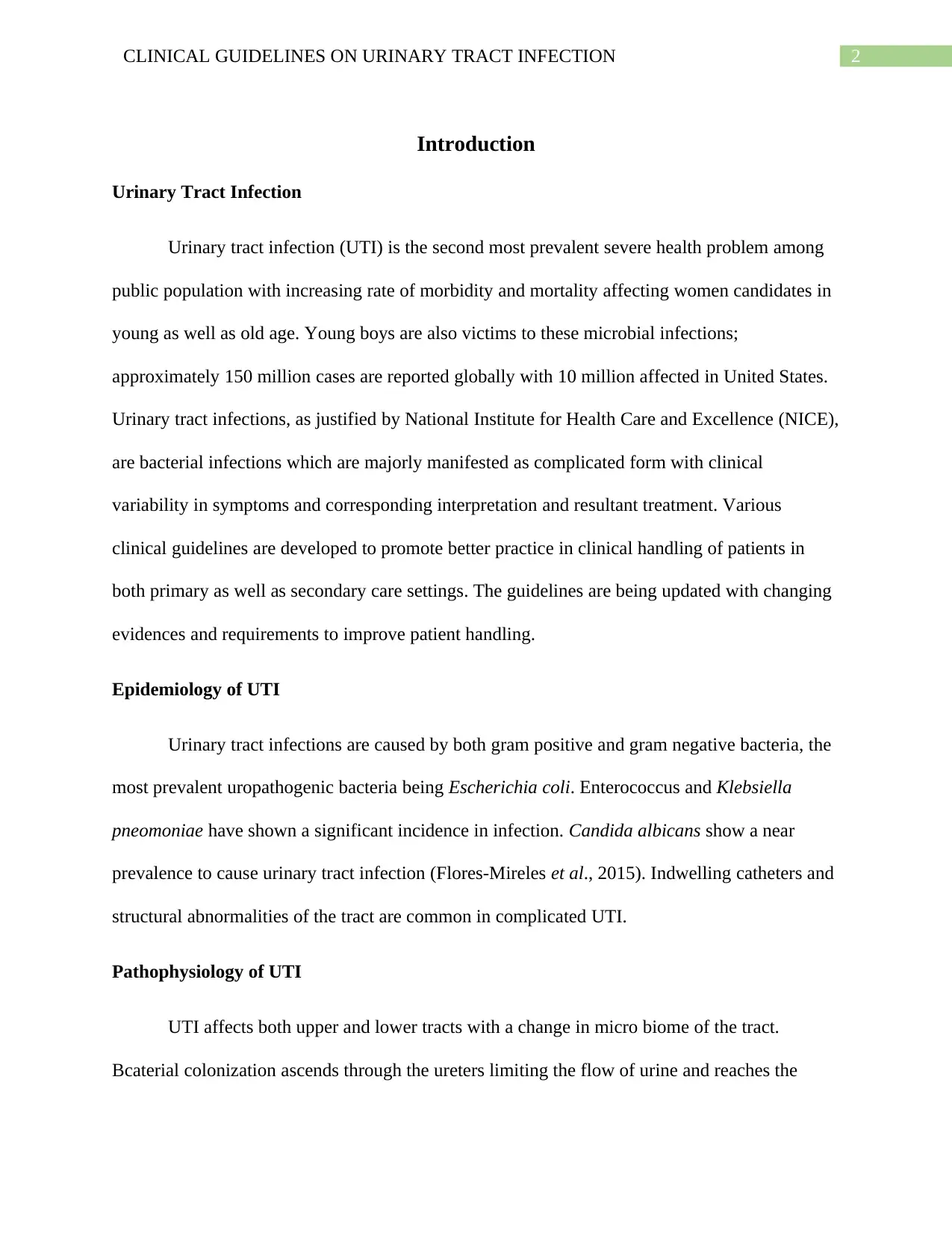
2CLINICAL GUIDELINES ON URINARY TRACT INFECTION
Introduction
Urinary Tract Infection
Urinary tract infection (UTI) is the second most prevalent severe health problem among
public population with increasing rate of morbidity and mortality affecting women candidates in
young as well as old age. Young boys are also victims to these microbial infections;
approximately 150 million cases are reported globally with 10 million affected in United States.
Urinary tract infections, as justified by National Institute for Health Care and Excellence (NICE),
are bacterial infections which are majorly manifested as complicated form with clinical
variability in symptoms and corresponding interpretation and resultant treatment. Various
clinical guidelines are developed to promote better practice in clinical handling of patients in
both primary as well as secondary care settings. The guidelines are being updated with changing
evidences and requirements to improve patient handling.
Epidemiology of UTI
Urinary tract infections are caused by both gram positive and gram negative bacteria, the
most prevalent uropathogenic bacteria being Escherichia coli. Enterococcus and Klebsiella
pneomoniae have shown a significant incidence in infection. Candida albicans show a near
prevalence to cause urinary tract infection (Flores-Mireles et al., 2015). Indwelling catheters and
structural abnormalities of the tract are common in complicated UTI.
Pathophysiology of UTI
UTI affects both upper and lower tracts with a change in micro biome of the tract.
Bcaterial colonization ascends through the ureters limiting the flow of urine and reaches the
Introduction
Urinary Tract Infection
Urinary tract infection (UTI) is the second most prevalent severe health problem among
public population with increasing rate of morbidity and mortality affecting women candidates in
young as well as old age. Young boys are also victims to these microbial infections;
approximately 150 million cases are reported globally with 10 million affected in United States.
Urinary tract infections, as justified by National Institute for Health Care and Excellence (NICE),
are bacterial infections which are majorly manifested as complicated form with clinical
variability in symptoms and corresponding interpretation and resultant treatment. Various
clinical guidelines are developed to promote better practice in clinical handling of patients in
both primary as well as secondary care settings. The guidelines are being updated with changing
evidences and requirements to improve patient handling.
Epidemiology of UTI
Urinary tract infections are caused by both gram positive and gram negative bacteria, the
most prevalent uropathogenic bacteria being Escherichia coli. Enterococcus and Klebsiella
pneomoniae have shown a significant incidence in infection. Candida albicans show a near
prevalence to cause urinary tract infection (Flores-Mireles et al., 2015). Indwelling catheters and
structural abnormalities of the tract are common in complicated UTI.
Pathophysiology of UTI
UTI affects both upper and lower tracts with a change in micro biome of the tract.
Bcaterial colonization ascends through the ureters limiting the flow of urine and reaches the
⊘ This is a preview!⊘
Do you want full access?
Subscribe today to unlock all pages.

Trusted by 1+ million students worldwide
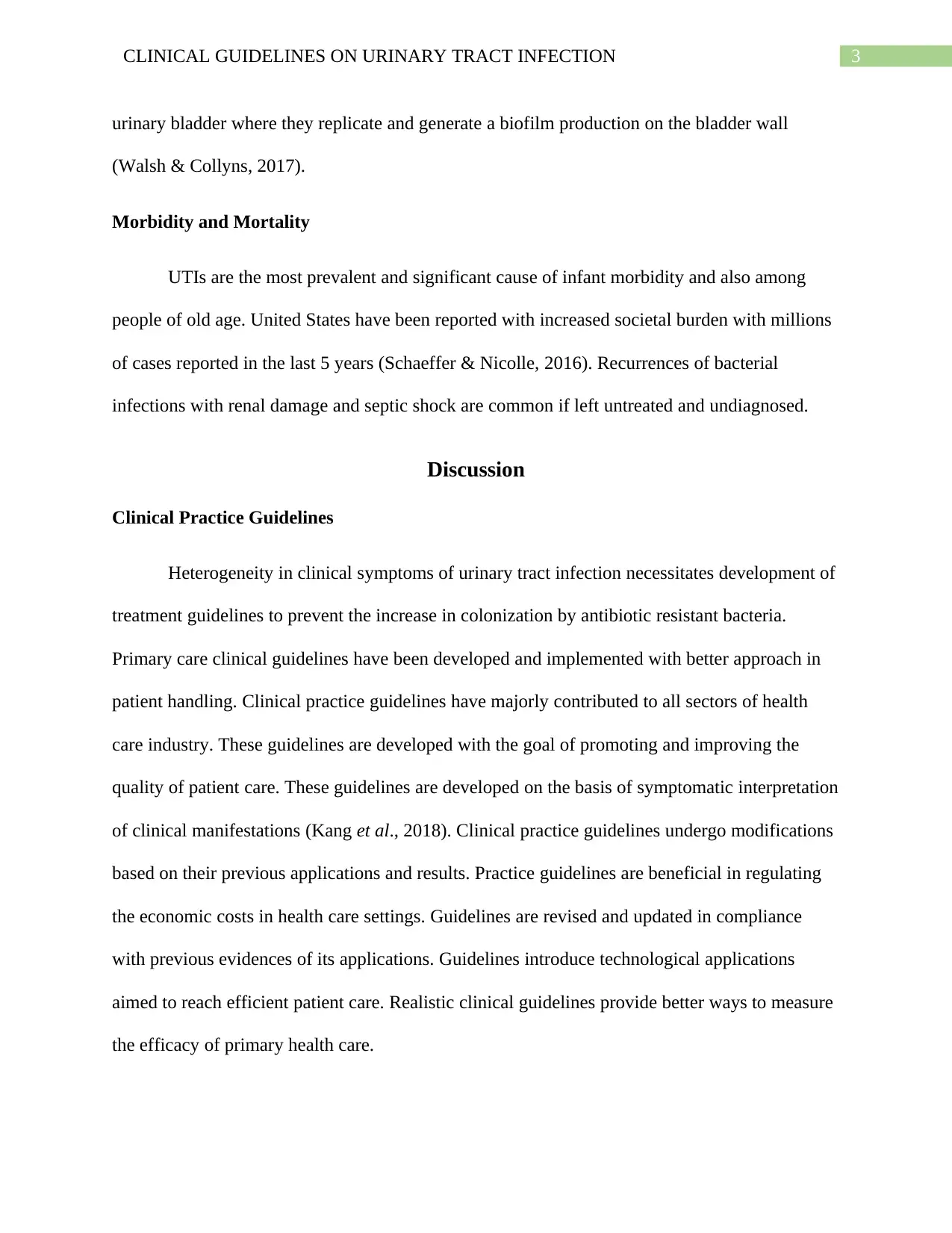
3CLINICAL GUIDELINES ON URINARY TRACT INFECTION
urinary bladder where they replicate and generate a biofilm production on the bladder wall
(Walsh & Collyns, 2017).
Morbidity and Mortality
UTIs are the most prevalent and significant cause of infant morbidity and also among
people of old age. United States have been reported with increased societal burden with millions
of cases reported in the last 5 years (Schaeffer & Nicolle, 2016). Recurrences of bacterial
infections with renal damage and septic shock are common if left untreated and undiagnosed.
Discussion
Clinical Practice Guidelines
Heterogeneity in clinical symptoms of urinary tract infection necessitates development of
treatment guidelines to prevent the increase in colonization by antibiotic resistant bacteria.
Primary care clinical guidelines have been developed and implemented with better approach in
patient handling. Clinical practice guidelines have majorly contributed to all sectors of health
care industry. These guidelines are developed with the goal of promoting and improving the
quality of patient care. These guidelines are developed on the basis of symptomatic interpretation
of clinical manifestations (Kang et al., 2018). Clinical practice guidelines undergo modifications
based on their previous applications and results. Practice guidelines are beneficial in regulating
the economic costs in health care settings. Guidelines are revised and updated in compliance
with previous evidences of its applications. Guidelines introduce technological applications
aimed to reach efficient patient care. Realistic clinical guidelines provide better ways to measure
the efficacy of primary health care.
urinary bladder where they replicate and generate a biofilm production on the bladder wall
(Walsh & Collyns, 2017).
Morbidity and Mortality
UTIs are the most prevalent and significant cause of infant morbidity and also among
people of old age. United States have been reported with increased societal burden with millions
of cases reported in the last 5 years (Schaeffer & Nicolle, 2016). Recurrences of bacterial
infections with renal damage and septic shock are common if left untreated and undiagnosed.
Discussion
Clinical Practice Guidelines
Heterogeneity in clinical symptoms of urinary tract infection necessitates development of
treatment guidelines to prevent the increase in colonization by antibiotic resistant bacteria.
Primary care clinical guidelines have been developed and implemented with better approach in
patient handling. Clinical practice guidelines have majorly contributed to all sectors of health
care industry. These guidelines are developed with the goal of promoting and improving the
quality of patient care. These guidelines are developed on the basis of symptomatic interpretation
of clinical manifestations (Kang et al., 2018). Clinical practice guidelines undergo modifications
based on their previous applications and results. Practice guidelines are beneficial in regulating
the economic costs in health care settings. Guidelines are revised and updated in compliance
with previous evidences of its applications. Guidelines introduce technological applications
aimed to reach efficient patient care. Realistic clinical guidelines provide better ways to measure
the efficacy of primary health care.
Paraphrase This Document
Need a fresh take? Get an instant paraphrase of this document with our AI Paraphraser
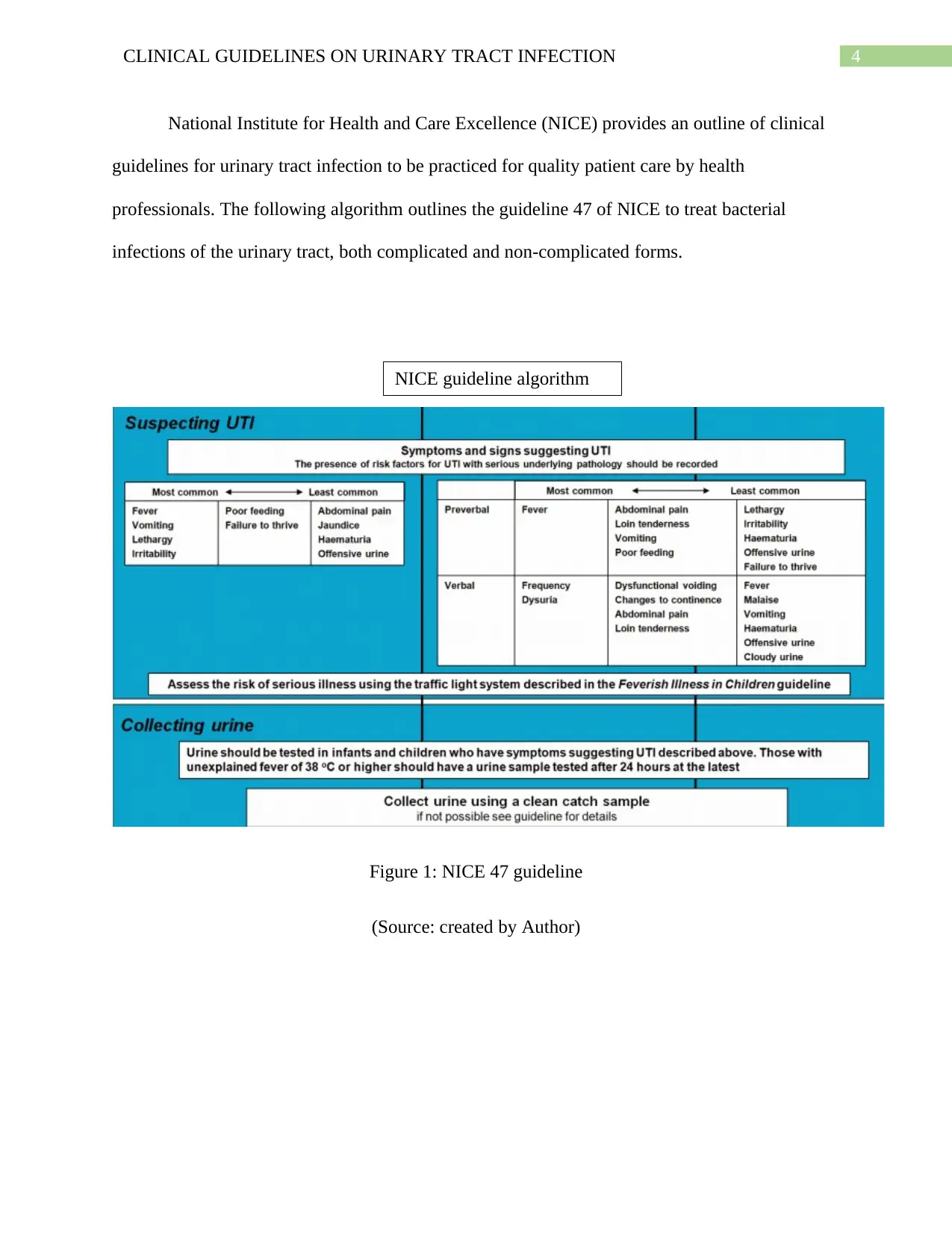
4CLINICAL GUIDELINES ON URINARY TRACT INFECTION
National Institute for Health and Care Excellence (NICE) provides an outline of clinical
guidelines for urinary tract infection to be practiced for quality patient care by health
professionals. The following algorithm outlines the guideline 47 of NICE to treat bacterial
infections of the urinary tract, both complicated and non-complicated forms.
Figure 1: NICE 47 guideline
(Source: created by Author)
NICE guideline algorithm
National Institute for Health and Care Excellence (NICE) provides an outline of clinical
guidelines for urinary tract infection to be practiced for quality patient care by health
professionals. The following algorithm outlines the guideline 47 of NICE to treat bacterial
infections of the urinary tract, both complicated and non-complicated forms.
Figure 1: NICE 47 guideline
(Source: created by Author)
NICE guideline algorithm
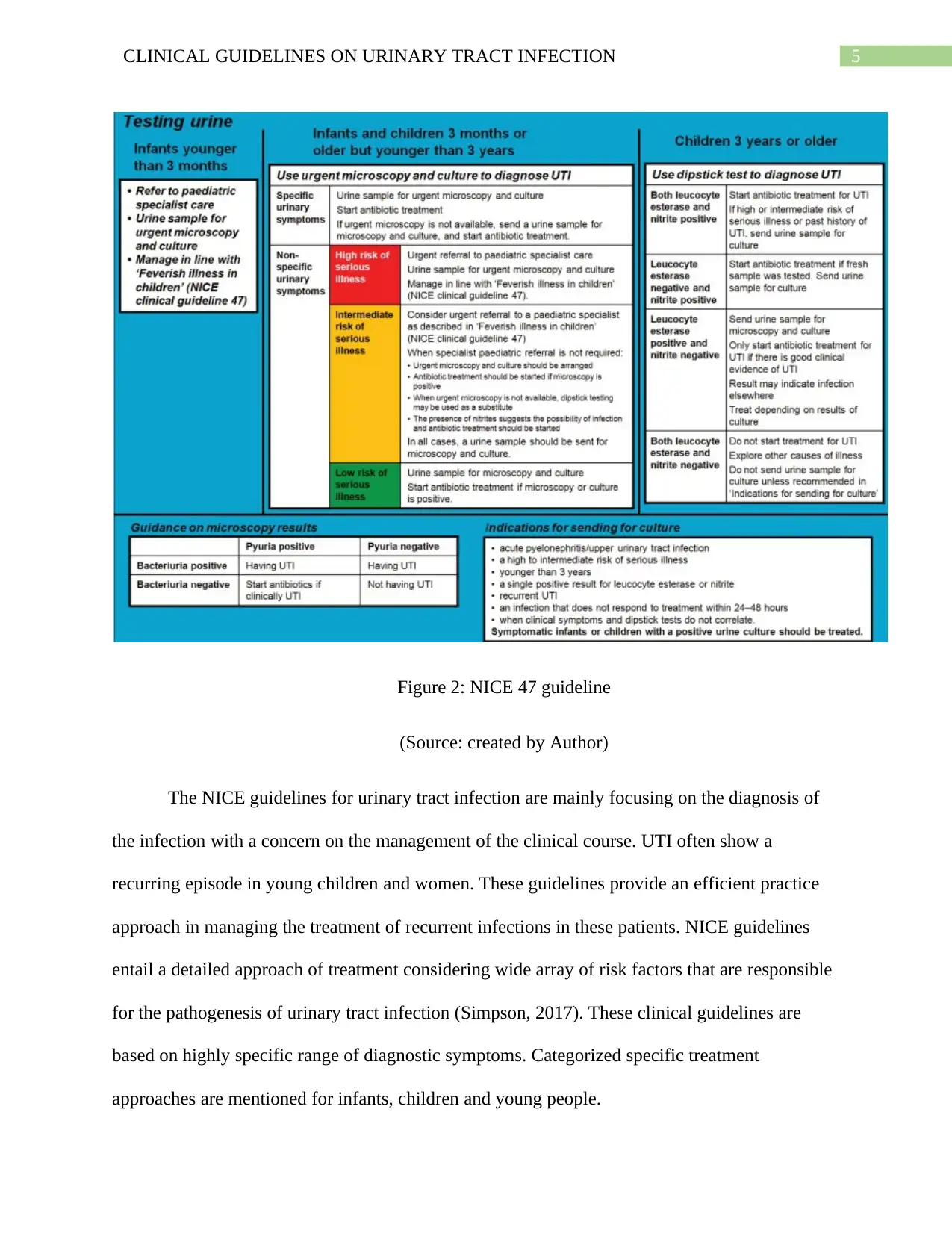
5CLINICAL GUIDELINES ON URINARY TRACT INFECTION
Figure 2: NICE 47 guideline
(Source: created by Author)
The NICE guidelines for urinary tract infection are mainly focusing on the diagnosis of
the infection with a concern on the management of the clinical course. UTI often show a
recurring episode in young children and women. These guidelines provide an efficient practice
approach in managing the treatment of recurrent infections in these patients. NICE guidelines
entail a detailed approach of treatment considering wide array of risk factors that are responsible
for the pathogenesis of urinary tract infection (Simpson, 2017). These clinical guidelines are
based on highly specific range of diagnostic symptoms. Categorized specific treatment
approaches are mentioned for infants, children and young people.
Figure 2: NICE 47 guideline
(Source: created by Author)
The NICE guidelines for urinary tract infection are mainly focusing on the diagnosis of
the infection with a concern on the management of the clinical course. UTI often show a
recurring episode in young children and women. These guidelines provide an efficient practice
approach in managing the treatment of recurrent infections in these patients. NICE guidelines
entail a detailed approach of treatment considering wide array of risk factors that are responsible
for the pathogenesis of urinary tract infection (Simpson, 2017). These clinical guidelines are
based on highly specific range of diagnostic symptoms. Categorized specific treatment
approaches are mentioned for infants, children and young people.
⊘ This is a preview!⊘
Do you want full access?
Subscribe today to unlock all pages.

Trusted by 1+ million students worldwide
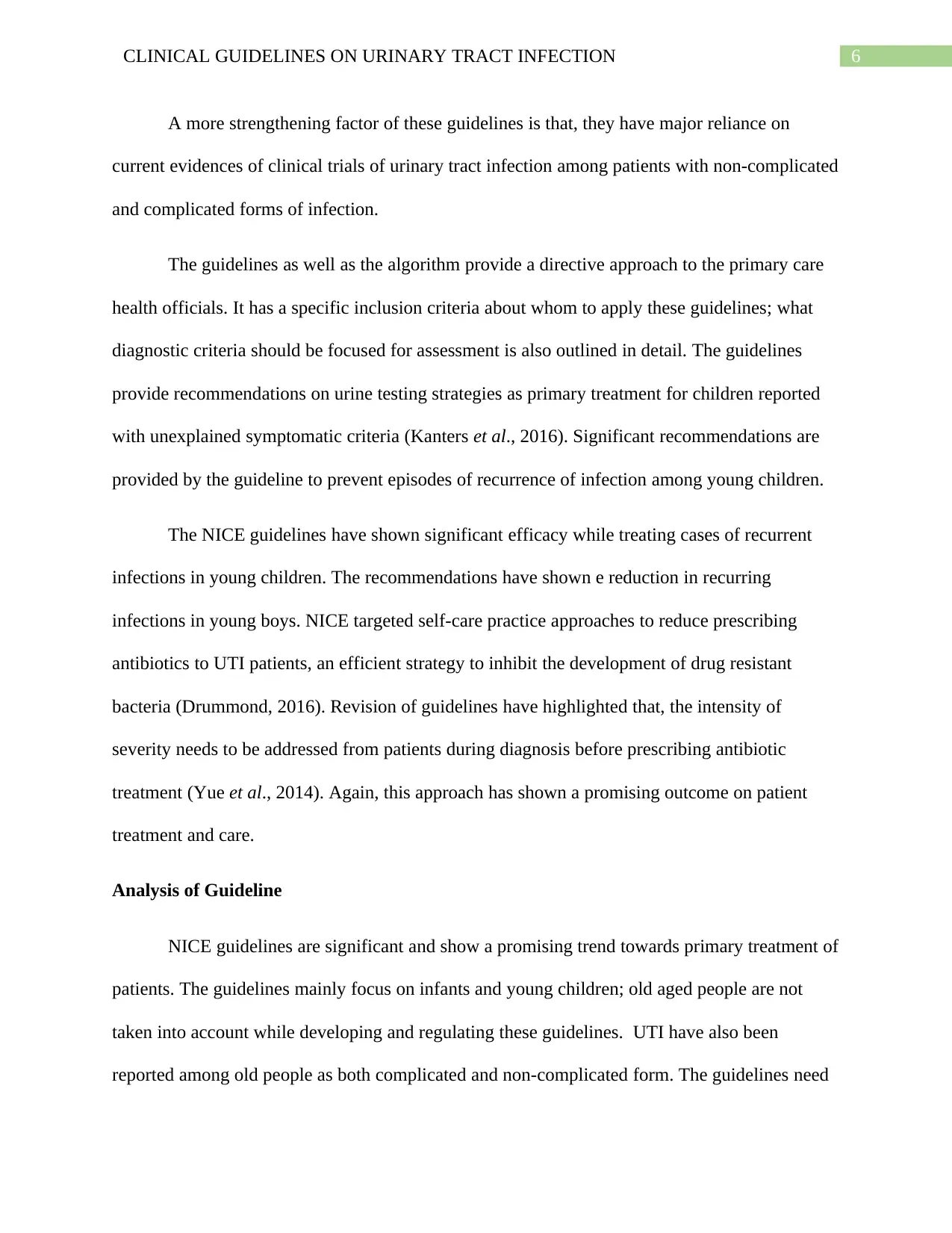
6CLINICAL GUIDELINES ON URINARY TRACT INFECTION
A more strengthening factor of these guidelines is that, they have major reliance on
current evidences of clinical trials of urinary tract infection among patients with non-complicated
and complicated forms of infection.
The guidelines as well as the algorithm provide a directive approach to the primary care
health officials. It has a specific inclusion criteria about whom to apply these guidelines; what
diagnostic criteria should be focused for assessment is also outlined in detail. The guidelines
provide recommendations on urine testing strategies as primary treatment for children reported
with unexplained symptomatic criteria (Kanters et al., 2016). Significant recommendations are
provided by the guideline to prevent episodes of recurrence of infection among young children.
The NICE guidelines have shown significant efficacy while treating cases of recurrent
infections in young children. The recommendations have shown e reduction in recurring
infections in young boys. NICE targeted self-care practice approaches to reduce prescribing
antibiotics to UTI patients, an efficient strategy to inhibit the development of drug resistant
bacteria (Drummond, 2016). Revision of guidelines have highlighted that, the intensity of
severity needs to be addressed from patients during diagnosis before prescribing antibiotic
treatment (Yue et al., 2014). Again, this approach has shown a promising outcome on patient
treatment and care.
Analysis of Guideline
NICE guidelines are significant and show a promising trend towards primary treatment of
patients. The guidelines mainly focus on infants and young children; old aged people are not
taken into account while developing and regulating these guidelines. UTI have also been
reported among old people as both complicated and non-complicated form. The guidelines need
A more strengthening factor of these guidelines is that, they have major reliance on
current evidences of clinical trials of urinary tract infection among patients with non-complicated
and complicated forms of infection.
The guidelines as well as the algorithm provide a directive approach to the primary care
health officials. It has a specific inclusion criteria about whom to apply these guidelines; what
diagnostic criteria should be focused for assessment is also outlined in detail. The guidelines
provide recommendations on urine testing strategies as primary treatment for children reported
with unexplained symptomatic criteria (Kanters et al., 2016). Significant recommendations are
provided by the guideline to prevent episodes of recurrence of infection among young children.
The NICE guidelines have shown significant efficacy while treating cases of recurrent
infections in young children. The recommendations have shown e reduction in recurring
infections in young boys. NICE targeted self-care practice approaches to reduce prescribing
antibiotics to UTI patients, an efficient strategy to inhibit the development of drug resistant
bacteria (Drummond, 2016). Revision of guidelines have highlighted that, the intensity of
severity needs to be addressed from patients during diagnosis before prescribing antibiotic
treatment (Yue et al., 2014). Again, this approach has shown a promising outcome on patient
treatment and care.
Analysis of Guideline
NICE guidelines are significant and show a promising trend towards primary treatment of
patients. The guidelines mainly focus on infants and young children; old aged people are not
taken into account while developing and regulating these guidelines. UTI have also been
reported among old people as both complicated and non-complicated form. The guidelines need
Paraphrase This Document
Need a fresh take? Get an instant paraphrase of this document with our AI Paraphraser
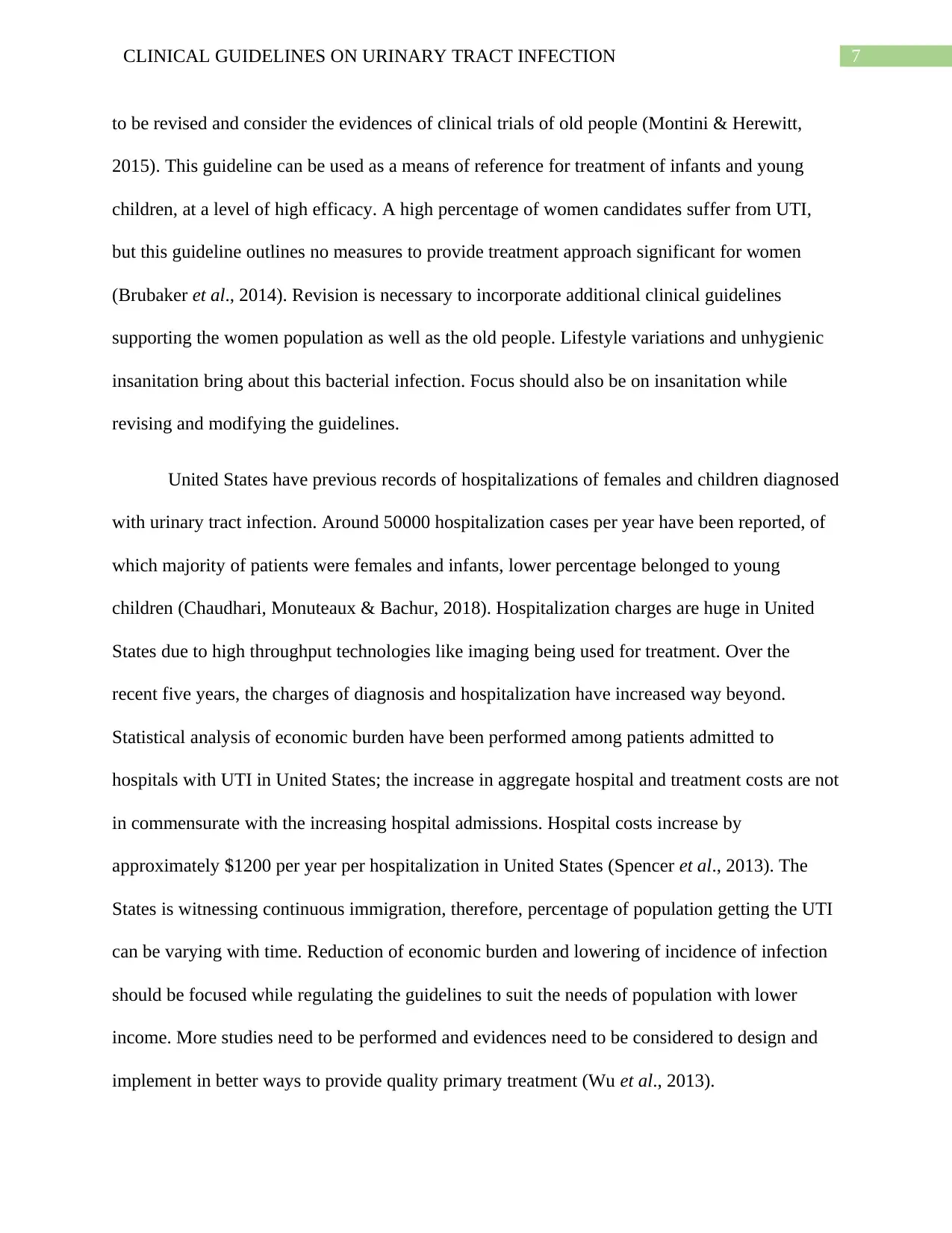
7CLINICAL GUIDELINES ON URINARY TRACT INFECTION
to be revised and consider the evidences of clinical trials of old people (Montini & Herewitt,
2015). This guideline can be used as a means of reference for treatment of infants and young
children, at a level of high efficacy. A high percentage of women candidates suffer from UTI,
but this guideline outlines no measures to provide treatment approach significant for women
(Brubaker et al., 2014). Revision is necessary to incorporate additional clinical guidelines
supporting the women population as well as the old people. Lifestyle variations and unhygienic
insanitation bring about this bacterial infection. Focus should also be on insanitation while
revising and modifying the guidelines.
United States have previous records of hospitalizations of females and children diagnosed
with urinary tract infection. Around 50000 hospitalization cases per year have been reported, of
which majority of patients were females and infants, lower percentage belonged to young
children (Chaudhari, Monuteaux & Bachur, 2018). Hospitalization charges are huge in United
States due to high throughput technologies like imaging being used for treatment. Over the
recent five years, the charges of diagnosis and hospitalization have increased way beyond.
Statistical analysis of economic burden have been performed among patients admitted to
hospitals with UTI in United States; the increase in aggregate hospital and treatment costs are not
in commensurate with the increasing hospital admissions. Hospital costs increase by
approximately $1200 per year per hospitalization in United States (Spencer et al., 2013). The
States is witnessing continuous immigration, therefore, percentage of population getting the UTI
can be varying with time. Reduction of economic burden and lowering of incidence of infection
should be focused while regulating the guidelines to suit the needs of population with lower
income. More studies need to be performed and evidences need to be considered to design and
implement in better ways to provide quality primary treatment (Wu et al., 2013).
to be revised and consider the evidences of clinical trials of old people (Montini & Herewitt,
2015). This guideline can be used as a means of reference for treatment of infants and young
children, at a level of high efficacy. A high percentage of women candidates suffer from UTI,
but this guideline outlines no measures to provide treatment approach significant for women
(Brubaker et al., 2014). Revision is necessary to incorporate additional clinical guidelines
supporting the women population as well as the old people. Lifestyle variations and unhygienic
insanitation bring about this bacterial infection. Focus should also be on insanitation while
revising and modifying the guidelines.
United States have previous records of hospitalizations of females and children diagnosed
with urinary tract infection. Around 50000 hospitalization cases per year have been reported, of
which majority of patients were females and infants, lower percentage belonged to young
children (Chaudhari, Monuteaux & Bachur, 2018). Hospitalization charges are huge in United
States due to high throughput technologies like imaging being used for treatment. Over the
recent five years, the charges of diagnosis and hospitalization have increased way beyond.
Statistical analysis of economic burden have been performed among patients admitted to
hospitals with UTI in United States; the increase in aggregate hospital and treatment costs are not
in commensurate with the increasing hospital admissions. Hospital costs increase by
approximately $1200 per year per hospitalization in United States (Spencer et al., 2013). The
States is witnessing continuous immigration, therefore, percentage of population getting the UTI
can be varying with time. Reduction of economic burden and lowering of incidence of infection
should be focused while regulating the guidelines to suit the needs of population with lower
income. More studies need to be performed and evidences need to be considered to design and
implement in better ways to provide quality primary treatment (Wu et al., 2013).
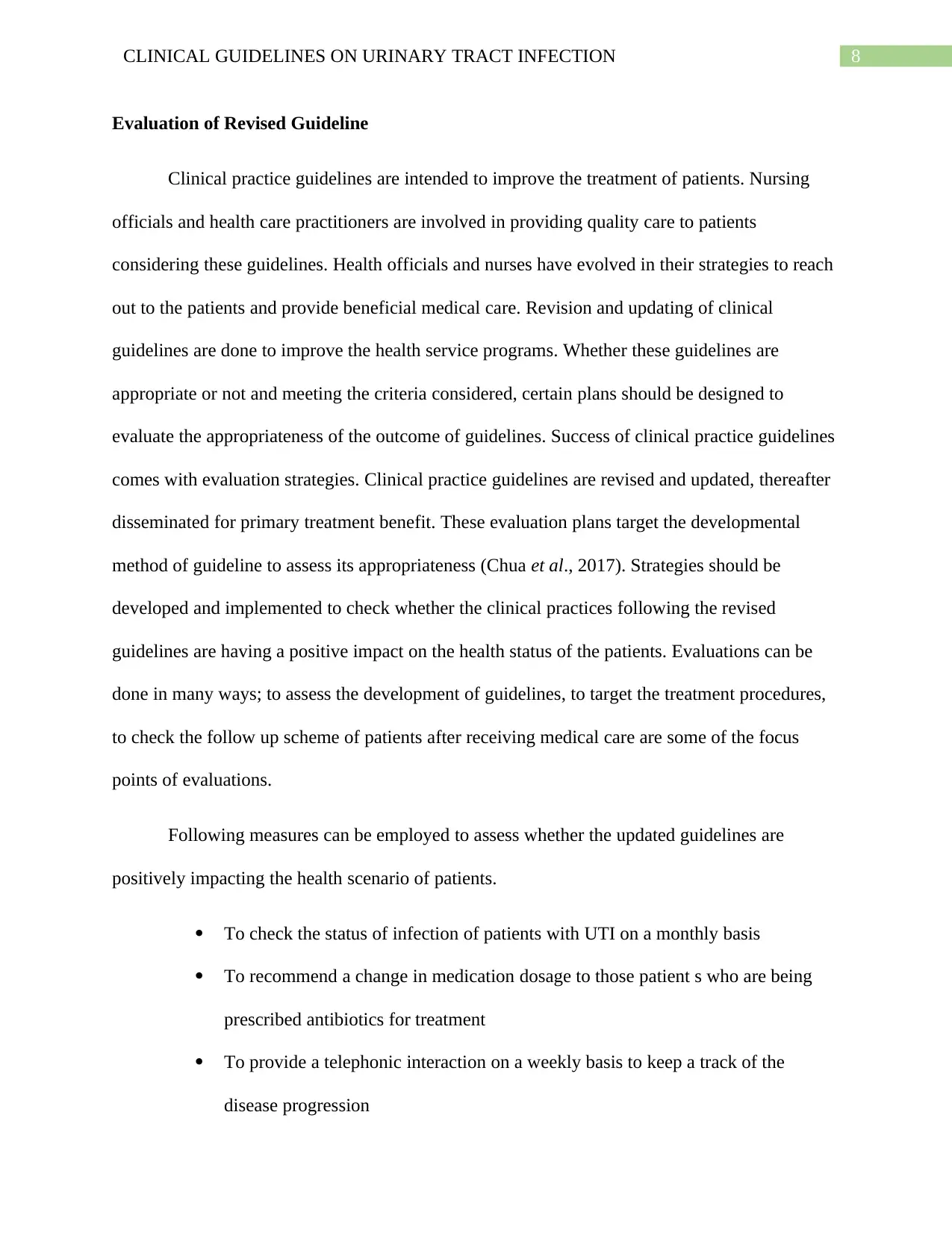
8CLINICAL GUIDELINES ON URINARY TRACT INFECTION
Evaluation of Revised Guideline
Clinical practice guidelines are intended to improve the treatment of patients. Nursing
officials and health care practitioners are involved in providing quality care to patients
considering these guidelines. Health officials and nurses have evolved in their strategies to reach
out to the patients and provide beneficial medical care. Revision and updating of clinical
guidelines are done to improve the health service programs. Whether these guidelines are
appropriate or not and meeting the criteria considered, certain plans should be designed to
evaluate the appropriateness of the outcome of guidelines. Success of clinical practice guidelines
comes with evaluation strategies. Clinical practice guidelines are revised and updated, thereafter
disseminated for primary treatment benefit. These evaluation plans target the developmental
method of guideline to assess its appropriateness (Chua et al., 2017). Strategies should be
developed and implemented to check whether the clinical practices following the revised
guidelines are having a positive impact on the health status of the patients. Evaluations can be
done in many ways; to assess the development of guidelines, to target the treatment procedures,
to check the follow up scheme of patients after receiving medical care are some of the focus
points of evaluations.
Following measures can be employed to assess whether the updated guidelines are
positively impacting the health scenario of patients.
To check the status of infection of patients with UTI on a monthly basis
To recommend a change in medication dosage to those patient s who are being
prescribed antibiotics for treatment
To provide a telephonic interaction on a weekly basis to keep a track of the
disease progression
Evaluation of Revised Guideline
Clinical practice guidelines are intended to improve the treatment of patients. Nursing
officials and health care practitioners are involved in providing quality care to patients
considering these guidelines. Health officials and nurses have evolved in their strategies to reach
out to the patients and provide beneficial medical care. Revision and updating of clinical
guidelines are done to improve the health service programs. Whether these guidelines are
appropriate or not and meeting the criteria considered, certain plans should be designed to
evaluate the appropriateness of the outcome of guidelines. Success of clinical practice guidelines
comes with evaluation strategies. Clinical practice guidelines are revised and updated, thereafter
disseminated for primary treatment benefit. These evaluation plans target the developmental
method of guideline to assess its appropriateness (Chua et al., 2017). Strategies should be
developed and implemented to check whether the clinical practices following the revised
guidelines are having a positive impact on the health status of the patients. Evaluations can be
done in many ways; to assess the development of guidelines, to target the treatment procedures,
to check the follow up scheme of patients after receiving medical care are some of the focus
points of evaluations.
Following measures can be employed to assess whether the updated guidelines are
positively impacting the health scenario of patients.
To check the status of infection of patients with UTI on a monthly basis
To recommend a change in medication dosage to those patient s who are being
prescribed antibiotics for treatment
To provide a telephonic interaction on a weekly basis to keep a track of the
disease progression
⊘ This is a preview!⊘
Do you want full access?
Subscribe today to unlock all pages.

Trusted by 1+ million students worldwide
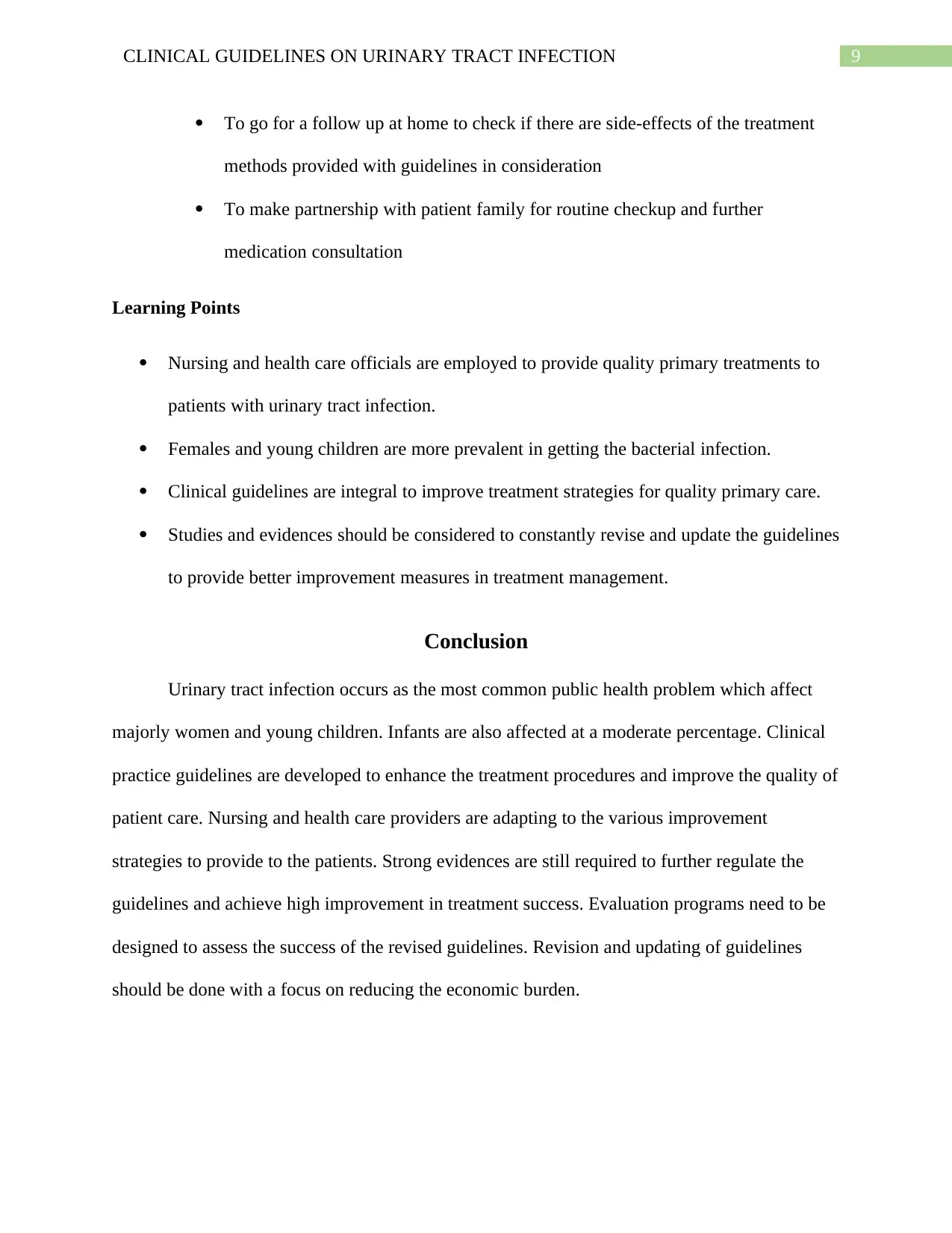
9CLINICAL GUIDELINES ON URINARY TRACT INFECTION
To go for a follow up at home to check if there are side-effects of the treatment
methods provided with guidelines in consideration
To make partnership with patient family for routine checkup and further
medication consultation
Learning Points
Nursing and health care officials are employed to provide quality primary treatments to
patients with urinary tract infection.
Females and young children are more prevalent in getting the bacterial infection.
Clinical guidelines are integral to improve treatment strategies for quality primary care.
Studies and evidences should be considered to constantly revise and update the guidelines
to provide better improvement measures in treatment management.
Conclusion
Urinary tract infection occurs as the most common public health problem which affect
majorly women and young children. Infants are also affected at a moderate percentage. Clinical
practice guidelines are developed to enhance the treatment procedures and improve the quality of
patient care. Nursing and health care providers are adapting to the various improvement
strategies to provide to the patients. Strong evidences are still required to further regulate the
guidelines and achieve high improvement in treatment success. Evaluation programs need to be
designed to assess the success of the revised guidelines. Revision and updating of guidelines
should be done with a focus on reducing the economic burden.
To go for a follow up at home to check if there are side-effects of the treatment
methods provided with guidelines in consideration
To make partnership with patient family for routine checkup and further
medication consultation
Learning Points
Nursing and health care officials are employed to provide quality primary treatments to
patients with urinary tract infection.
Females and young children are more prevalent in getting the bacterial infection.
Clinical guidelines are integral to improve treatment strategies for quality primary care.
Studies and evidences should be considered to constantly revise and update the guidelines
to provide better improvement measures in treatment management.
Conclusion
Urinary tract infection occurs as the most common public health problem which affect
majorly women and young children. Infants are also affected at a moderate percentage. Clinical
practice guidelines are developed to enhance the treatment procedures and improve the quality of
patient care. Nursing and health care providers are adapting to the various improvement
strategies to provide to the patients. Strong evidences are still required to further regulate the
guidelines and achieve high improvement in treatment success. Evaluation programs need to be
designed to assess the success of the revised guidelines. Revision and updating of guidelines
should be done with a focus on reducing the economic burden.
Paraphrase This Document
Need a fresh take? Get an instant paraphrase of this document with our AI Paraphraser
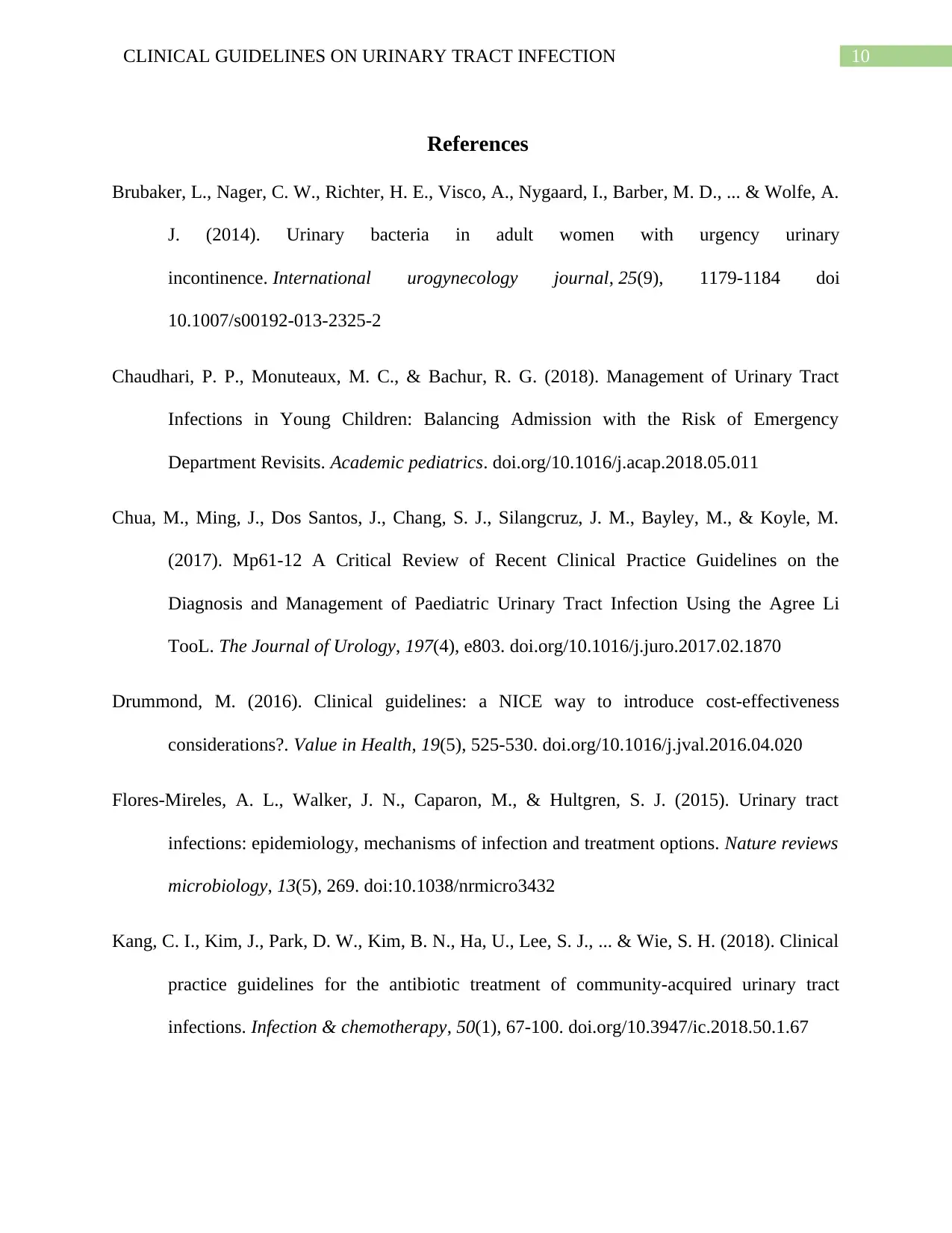
10CLINICAL GUIDELINES ON URINARY TRACT INFECTION
References
Brubaker, L., Nager, C. W., Richter, H. E., Visco, A., Nygaard, I., Barber, M. D., ... & Wolfe, A.
J. (2014). Urinary bacteria in adult women with urgency urinary
incontinence. International urogynecology journal, 25(9), 1179-1184 doi
10.1007/s00192-013-2325-2
Chaudhari, P. P., Monuteaux, M. C., & Bachur, R. G. (2018). Management of Urinary Tract
Infections in Young Children: Balancing Admission with the Risk of Emergency
Department Revisits. Academic pediatrics. doi.org/10.1016/j.acap.2018.05.011
Chua, M., Ming, J., Dos Santos, J., Chang, S. J., Silangcruz, J. M., Bayley, M., & Koyle, M.
(2017). Mp61-12 A Critical Review of Recent Clinical Practice Guidelines on the
Diagnosis and Management of Paediatric Urinary Tract Infection Using the Agree Li
TooL. The Journal of Urology, 197(4), e803. doi.org/10.1016/j.juro.2017.02.1870
Drummond, M. (2016). Clinical guidelines: a NICE way to introduce cost-effectiveness
considerations?. Value in Health, 19(5), 525-530. doi.org/10.1016/j.jval.2016.04.020
Flores-Mireles, A. L., Walker, J. N., Caparon, M., & Hultgren, S. J. (2015). Urinary tract
infections: epidemiology, mechanisms of infection and treatment options. Nature reviews
microbiology, 13(5), 269. doi:10.1038/nrmicro3432
Kang, C. I., Kim, J., Park, D. W., Kim, B. N., Ha, U., Lee, S. J., ... & Wie, S. H. (2018). Clinical
practice guidelines for the antibiotic treatment of community-acquired urinary tract
infections. Infection & chemotherapy, 50(1), 67-100. doi.org/10.3947/ic.2018.50.1.67
References
Brubaker, L., Nager, C. W., Richter, H. E., Visco, A., Nygaard, I., Barber, M. D., ... & Wolfe, A.
J. (2014). Urinary bacteria in adult women with urgency urinary
incontinence. International urogynecology journal, 25(9), 1179-1184 doi
10.1007/s00192-013-2325-2
Chaudhari, P. P., Monuteaux, M. C., & Bachur, R. G. (2018). Management of Urinary Tract
Infections in Young Children: Balancing Admission with the Risk of Emergency
Department Revisits. Academic pediatrics. doi.org/10.1016/j.acap.2018.05.011
Chua, M., Ming, J., Dos Santos, J., Chang, S. J., Silangcruz, J. M., Bayley, M., & Koyle, M.
(2017). Mp61-12 A Critical Review of Recent Clinical Practice Guidelines on the
Diagnosis and Management of Paediatric Urinary Tract Infection Using the Agree Li
TooL. The Journal of Urology, 197(4), e803. doi.org/10.1016/j.juro.2017.02.1870
Drummond, M. (2016). Clinical guidelines: a NICE way to introduce cost-effectiveness
considerations?. Value in Health, 19(5), 525-530. doi.org/10.1016/j.jval.2016.04.020
Flores-Mireles, A. L., Walker, J. N., Caparon, M., & Hultgren, S. J. (2015). Urinary tract
infections: epidemiology, mechanisms of infection and treatment options. Nature reviews
microbiology, 13(5), 269. doi:10.1038/nrmicro3432
Kang, C. I., Kim, J., Park, D. W., Kim, B. N., Ha, U., Lee, S. J., ... & Wie, S. H. (2018). Clinical
practice guidelines for the antibiotic treatment of community-acquired urinary tract
infections. Infection & chemotherapy, 50(1), 67-100. doi.org/10.3947/ic.2018.50.1.67
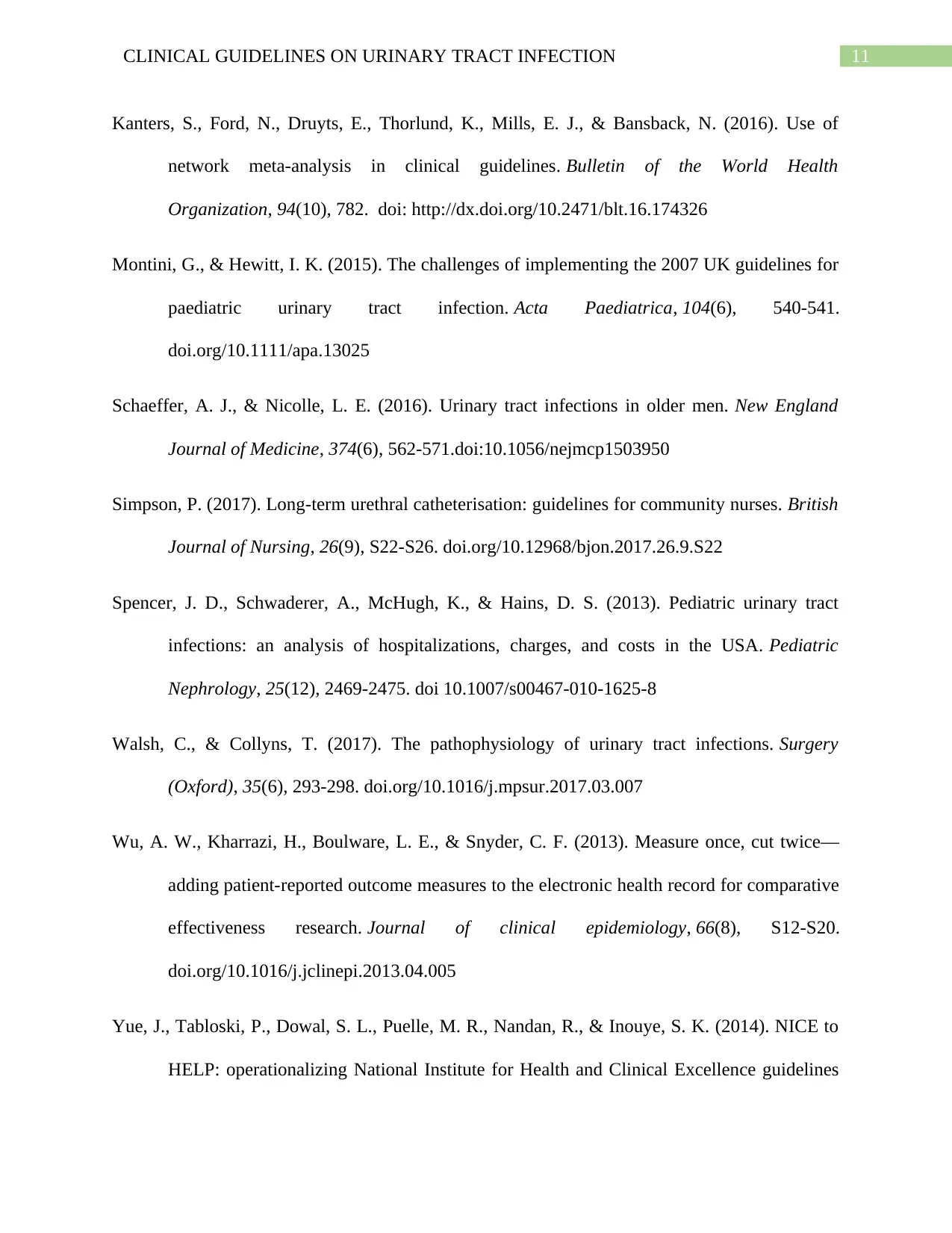
11CLINICAL GUIDELINES ON URINARY TRACT INFECTION
Kanters, S., Ford, N., Druyts, E., Thorlund, K., Mills, E. J., & Bansback, N. (2016). Use of
network meta-analysis in clinical guidelines. Bulletin of the World Health
Organization, 94(10), 782. doi: http://dx.doi.org/10.2471/blt.16.174326
Montini, G., & Hewitt, I. K. (2015). The challenges of implementing the 2007 UK guidelines for
paediatric urinary tract infection. Acta Paediatrica, 104(6), 540-541.
doi.org/10.1111/apa.13025
Schaeffer, A. J., & Nicolle, L. E. (2016). Urinary tract infections in older men. New England
Journal of Medicine, 374(6), 562-571.doi:10.1056/nejmcp1503950
Simpson, P. (2017). Long-term urethral catheterisation: guidelines for community nurses. British
Journal of Nursing, 26(9), S22-S26. doi.org/10.12968/bjon.2017.26.9.S22
Spencer, J. D., Schwaderer, A., McHugh, K., & Hains, D. S. (2013). Pediatric urinary tract
infections: an analysis of hospitalizations, charges, and costs in the USA. Pediatric
Nephrology, 25(12), 2469-2475. doi 10.1007/s00467-010-1625-8
Walsh, C., & Collyns, T. (2017). The pathophysiology of urinary tract infections. Surgery
(Oxford), 35(6), 293-298. doi.org/10.1016/j.mpsur.2017.03.007
Wu, A. W., Kharrazi, H., Boulware, L. E., & Snyder, C. F. (2013). Measure once, cut twice—
adding patient-reported outcome measures to the electronic health record for comparative
effectiveness research. Journal of clinical epidemiology, 66(8), S12-S20.
doi.org/10.1016/j.jclinepi.2013.04.005
Yue, J., Tabloski, P., Dowal, S. L., Puelle, M. R., Nandan, R., & Inouye, S. K. (2014). NICE to
HELP: operationalizing National Institute for Health and Clinical Excellence guidelines
Kanters, S., Ford, N., Druyts, E., Thorlund, K., Mills, E. J., & Bansback, N. (2016). Use of
network meta-analysis in clinical guidelines. Bulletin of the World Health
Organization, 94(10), 782. doi: http://dx.doi.org/10.2471/blt.16.174326
Montini, G., & Hewitt, I. K. (2015). The challenges of implementing the 2007 UK guidelines for
paediatric urinary tract infection. Acta Paediatrica, 104(6), 540-541.
doi.org/10.1111/apa.13025
Schaeffer, A. J., & Nicolle, L. E. (2016). Urinary tract infections in older men. New England
Journal of Medicine, 374(6), 562-571.doi:10.1056/nejmcp1503950
Simpson, P. (2017). Long-term urethral catheterisation: guidelines for community nurses. British
Journal of Nursing, 26(9), S22-S26. doi.org/10.12968/bjon.2017.26.9.S22
Spencer, J. D., Schwaderer, A., McHugh, K., & Hains, D. S. (2013). Pediatric urinary tract
infections: an analysis of hospitalizations, charges, and costs in the USA. Pediatric
Nephrology, 25(12), 2469-2475. doi 10.1007/s00467-010-1625-8
Walsh, C., & Collyns, T. (2017). The pathophysiology of urinary tract infections. Surgery
(Oxford), 35(6), 293-298. doi.org/10.1016/j.mpsur.2017.03.007
Wu, A. W., Kharrazi, H., Boulware, L. E., & Snyder, C. F. (2013). Measure once, cut twice—
adding patient-reported outcome measures to the electronic health record for comparative
effectiveness research. Journal of clinical epidemiology, 66(8), S12-S20.
doi.org/10.1016/j.jclinepi.2013.04.005
Yue, J., Tabloski, P., Dowal, S. L., Puelle, M. R., Nandan, R., & Inouye, S. K. (2014). NICE to
HELP: operationalizing National Institute for Health and Clinical Excellence guidelines
⊘ This is a preview!⊘
Do you want full access?
Subscribe today to unlock all pages.

Trusted by 1+ million students worldwide
1 out of 13
Related Documents
Your All-in-One AI-Powered Toolkit for Academic Success.
+13062052269
info@desklib.com
Available 24*7 on WhatsApp / Email
![[object Object]](/_next/static/media/star-bottom.7253800d.svg)
Unlock your academic potential
Copyright © 2020–2025 A2Z Services. All Rights Reserved. Developed and managed by ZUCOL.





